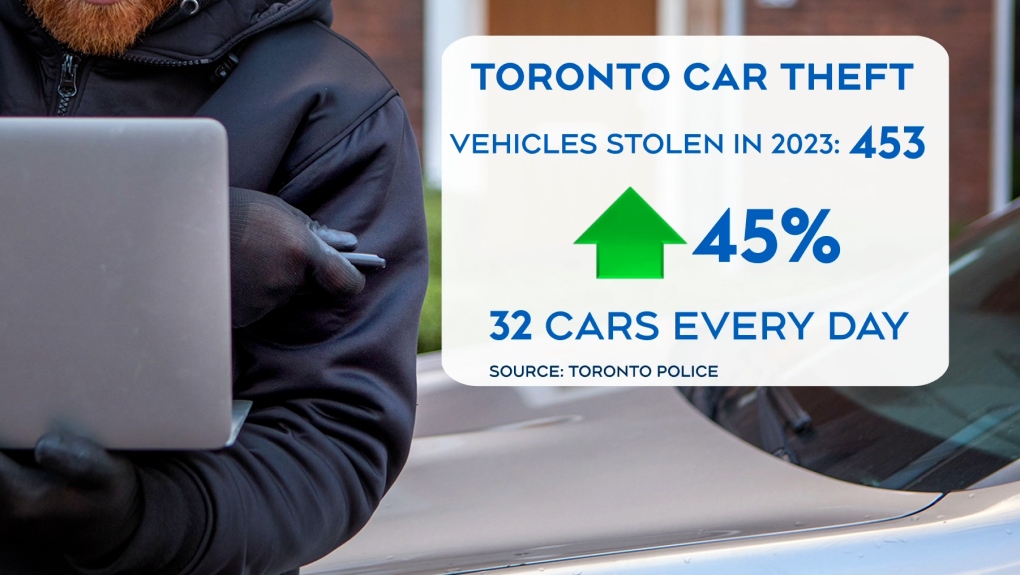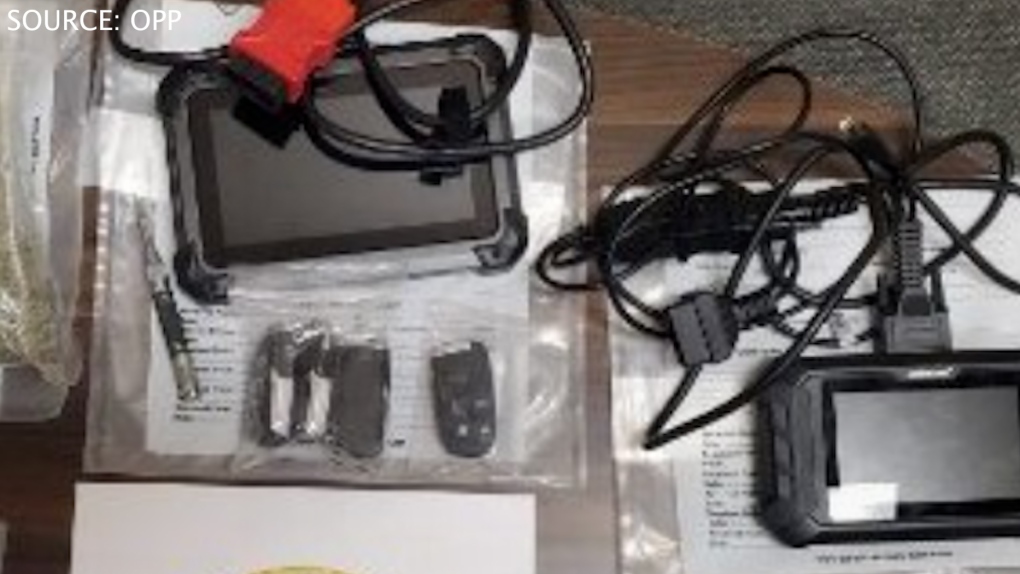New tricks leading to alarming rate of car thefts in Toronto
At least 32 cars have been stolen In Toronto each day so far in 2023, a surprising figure spurring calls for car manufacturers to catch up in a digital arms race with tech-savvy thieves.
Using a variety of tricks, like including portable devices that can access a car’s onboard computer, or tools that magnify a key fob’s signals, thieves can slip through digital defences and drive the cars away in minutes.
“I was shocked, to be honest with you,” Toronto man Zachary Kozak, whose Ram 1500 was stolen from his driveway this month, told CTV News Toronto.
Video from Kozak’s home shows two men disabling the horn on his truck, and the vehicle lights flashing silently. The thieves were able to access an onboard computer, allowing them to start the vehicle and drive away within seven minutes.
“They came in knowing what they wanted and knew exactly what they were doing,” Kozak said.
He said he’s frustrated because he believes he took reasonable security precautions, including using security cameras and keeping his key fob in a Faraday pouch, which blocks signals.
But it happened anyway. “Car manufacturers need to do more,” Kozak said.
In recent weeks, police in Ontario issued warnings about a rash of thefts of Ram trucks. In particular, Guelph, Waterloo, Brantford and South Simcoe have been targeted, police said.
In Toronto, police said the first two weeks of 2023 saw 453 vehicle thefts reported, a 48 per cent increase over the same period last year — an amount that surged to 32 a day.

In 2022, Toronto police reported 9,594 vehicles stolen, compared to 6,601 the previous year. Police responded with major operations like Project Touchdown, which seized 200 vehicles, and intercepted illegal guns and drugs, returning some $17 million from alleged organized criminals.
The increase has been widely felt in many parts of the country, said South Simcoe Police Service Staff Sgt. Dave Phillips.
“It appears the thieves have become very sophisticated. These vehicles have more modern comfort features that us, as drivers, enjoy, and it appears that these thieves have found a way to manipulate that piece of technology in their favour,” he said.
The technology tricks are one of several employed by thieves, who have traded a crowbar for portable devices, that can access a car through its onboard diagnostic port and reprogram it so that it recognizes a new key — the approach that appears to have worked with Kozak’s truck.
Another method is a relay attack, where thieves approach someone’s door with a wire designed to sense the signal from a key fob, amplify it, and trick the car into believing the owner’s key is inside the vehicle so it can be started.
Some Kias and Hyundais were so easy to steal that an American class-action lawsuit claims it became a challenge on the social media site TikTok.
 New tech can now trick a car into believing the owner’s key is inside the vehicle (OPP).
New tech can now trick a car into believing the owner’s key is inside the vehicle (OPP).
“The Kia challenge,” Buffalo Police Department Commissioner Joseph Gramaglia said last year. “They are easy, unfortunately, to steal.”
Cybersecurity expert Cladiu Popa told CTV News Toronto car companies need have better protections to defend against these thefts. Popa said companies need to add measures to defeat them, as well as infrastructure that can nimbly defeat future attacks, just like how computer operating systems are constantly downloading patches.
“One of the key issues today, is manufacturers are not keeping up with security vulnerabilities. That much is clear,” Popa said.
Some measures that have proven successful in the computer realm are passwords and dual authentication, he said, and car companies need to be thinking in that way.
“These are computers on wheels,” he said.
Stellantis, which makes the Ram, said it’s rolling out a new suite of security measures that will make it harder to clone key fobs and also include a feature that allows the vehicle owner to require a passcode for the vehicle to go faster than a certain speed.
Those measures are already in place for the Charger and the Challenger models, as every company attempts to improve features for what can be diverse and varied platforms on each car.
“We use industry standard technology. As with other vehicle features, we are engaged in continuous product improvement,” Stellantis said in a statement.
Those measures have yet to be imposed on the Ram model, which could explain why thieves appear to be targeting that model around Ontario.
Security shouldn’t be optional, said Kozak, who doesn’t want other vehicle owners to watch their cars drive away without them.
“I feel car manufacturers should do more,” he said.
CTVNews.ca Top Stories

Fall sitting bookended by Liberal byelection losses ends with Trudeau government in tumult
The House of Commons adjourned on Tuesday, bringing an end to an unstable fall sitting that has been bookended by Liberal byelection losses. The conclusion of the fall sitting comes as Prime Minister Justin Trudeau's minority government is in turmoil.
2 B.C. police officers charged with sexual assault
Two officers with a Vancouver Island police department have been charged with the sexual assault of a "vulnerable" woman, authorities announced Tuesday.
Canadian government announces new border security plan amid Donald Trump tariff threats
The federal government has laid out a five-pillared approach to boosting border security, though it doesn't include specifics about where and how the $1.3-billion funding package earmarked in the fall economic statement will be allocated.
B.C. teacher disciplined for refusing to let student use bathroom
A teacher who refused to let a student use the bathroom in a B.C. school has been disciplined by the province's professional regulator.
Most Canadians have heard about Freeland's resignation from Trudeau cabinet, new poll finds
The majority of Canadians heard about Chrystia Freeland's surprise resignation from Prime Minister Justin Trudeau's cabinet, according to a new poll from Abacus Data released Tuesday.
Police chief says motive for Wisconsin school shooting was a 'combination of factors'
Investigators on Tuesday are focused on trying to determine a motive in a Wisconsin school shooting that left a teacher and a student dead and two other children in critical condition.
After investigating Jan. 6, House GOP sides with Trump and goes after Liz Cheney
Wrapping up their own investigation on the Jan. 6 2021 Capitol attack, House Republicans have concluded it's former GOP Rep. Liz Cheney who should be prosecuted for probing what happened when then-President Donald Trump sent his mob of supporters as Congress was certifying the 2020 election.
Wine may be good for the heart, new study says, but experts aren’t convinced
Drinking a small amount of wine each day may protect the heart, according to a new study of Spanish people following the plant-based Mediterranean diet, which typically includes drinking a small glass of wine with dinner.
The Canada Post strike is over, but it will take time to get back to normal, says spokesperson
Canada Post workers are back on the job after a gruelling four-week strike that halted deliveries across the country, but it could take time before operations are back to normal.


































